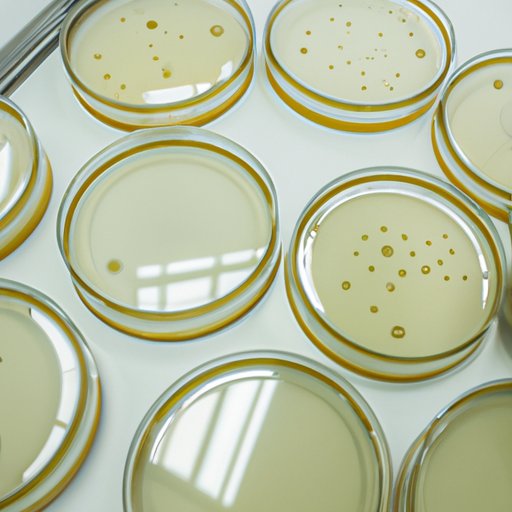Introduction
Bacterial culturing is the process of growing bacteria in a controlled environment. This is done by providing the right conditions for the bacteria to multiply and thrive. Culturing bacteria can be used for a variety of purposes, such as medical diagnostics, research, and food safety. In this article, we will explore the steps involved in culturing bacteria.
Setting Up a Sterile Environment
The first step in culturing bacteria is to create a sterile environment. This is essential in order to prevent contamination and ensure that the bacteria will grow properly. To set up a sterile environment, you will need the following equipment and materials:
- Sterile swabs
- Sterile pipettes
- Petri dishes
- Culture media
- Incubator
Once you have all the necessary equipment and materials, you can begin to prepare the working area. Start by cleaning the workbench with a disinfectant solution. Then, put on protective clothing, such as a lab coat, gloves, and a face mask. Next, sterilize all the equipment and materials that you will be using. You can do this by boiling them in hot water or by using an autoclave.

Types of Media Used for Culturing Bacteria
Once the working area is prepared, you can begin to select the type of media that will be used for culturing the bacteria. The most common types of media are nutrient broth, agar plates, and specialized media.
Nutrient Broth
Nutrient broth is a liquid medium that contains essential nutrients for the growth of bacteria. It usually consists of proteins, carbohydrates, salts, vitamins, and minerals. Nutrient broth can be used to cultivate a wide variety of bacteria, including both pathogenic and non-pathogenic species.
Agar Plates
Agar plates are solid media containing agar, a gelatinous substance derived from seaweed. Agar plates are commonly used in microbiology laboratories to isolate and identify different types of bacteria. They are also used to test the sensitivity of bacteria to antibiotics.
Specialized Media
Specialized media are designed for specific types of bacteria. These media contain specific ingredients that are necessary for the growth of certain bacteria. For example, some specialized media are designed for the growth of acid-loving bacteria, while others are designed for the growth of anaerobic bacteria.

Selecting and Preparing Samples for Culturing
Once you have selected the media that will be used for culturing the bacteria, you can begin to select and prepare the samples. First, decide where you will collect the samples. This could be from a patient’s body, a soil sample, or any other source. Once you have collected the samples, they should be stored in a sterile container and transported to the laboratory as soon as possible.
Once the samples arrive in the laboratory, they should be prepared for culturing. This involves diluting the samples and then plating them on the selected media. The dilution process ensures that the bacteria are evenly distributed across the plate, which helps to avoid overcrowding.

Transferring Bacterial Samples to Culture Plates
Once the samples are prepared, it is time to transfer them to the culture plates. There are two main methods for doing this: inoculation and streaking.
Inoculation Techniques
Inoculation techniques involve directly transferring bacterial samples to the culture plates. This method is often used when culturing large numbers of bacteria. Common inoculation techniques include the use of sterile swabs and pipettes.
Aseptic Technique
The aseptic technique is a method of transferring bacteria without introducing contaminants. This method involves using a flame to sterilize the loop or needle used to transfer the bacteria. This technique is often used when culturing small numbers of bacteria.
Incubation Process
Once the bacteria have been transferred to the culture plates, they must be incubated in order to allow them to grow. The incubation process involves controlling the temperature, oxygen levels, and humidity of the environment. Generally, the optimal conditions for culturing bacteria are between 25-30°C and 80-90% humidity.
It is important to monitor the environment regularly to ensure that the bacteria are growing properly. If the environment is too wet, the bacteria may not grow as well. On the other hand, if the environment is too dry, the bacteria may become dehydrated and die.
Conclusion
Culturing bacteria is a complex process that requires precise control over the environment. By following the steps outlined in this article, you can successfully culture a variety of bacteria. The key steps involve setting up a sterile environment, selecting and preparing samples for culturing, transferring bacterial samples to culture plates, and controlling the incubation process. Proper sterilization procedures are essential in order to prevent contamination and ensure that the bacteria will grow properly.
(Note: Is this article not meeting your expectations? Do you have knowledge or insights to share? Unlock new opportunities and expand your reach by joining our authors team. Click Registration to join us and share your expertise with our readers.)
